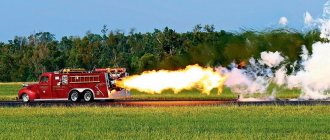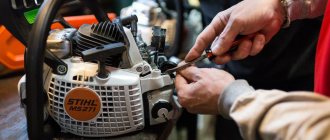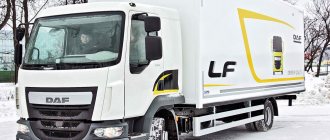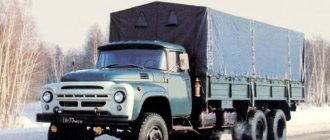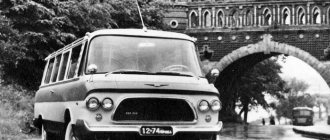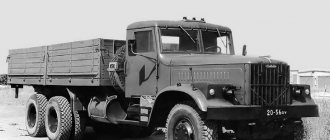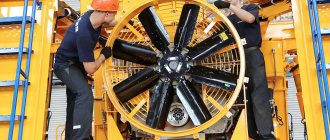I constantly drive my car along country roads and often see trucks on them. This is a familiar picture for any region of the country, and every motorist knows perfectly well what a truck looks like in our country. However, recently I was watching an old American film, and one interesting detail caught my eye.
I noticed that in US movies all tractors and trucks have an elongated nose. In our country, and in European countries too, transport of the same class looks different.
You can independently make several assumptions: American truckers stored something in the “muzzle” or there was a place to spend the night there, larger engines are used that cannot be placed otherwise.
This is just a guess. I'm interested to know how things really are. As a result, we managed to find out why American road trains have such an unusual appearance.
What is the difference
For many years now, trucks with a bonnet body have been a kind of calling card of “overseas” truckers. And with various theories, it is quite easy to explain the presence of a “muzzle”. The fact is that tractors produced in the United States, unlike European models, are made in a classic layout.
That is why the power unit received its rightful place in the design of the vehicle, and is not “bashfully” hidden under the driver’s cabin, as is done in cars produced in Russia and other countries. Therefore, it is worth asking the question a little differently: why in Europe they began to make trucks without a hood.
Cargoautoinfo. Freight transport in detail.
The idea of making a hooded car using the “budget” method, which MAZ used, is not new. In the history of the automotive industry, it has been used quite successfully by many class=”aligncenter” width=”800″ height=”533″[/img] The “block” concept of Scania, first implemented on cars of the “zero” family in 1972, is also well known. Until the hooded models were discontinued, their cabins were unified over five generations.
Since the post-war period, when the cabover layout began to gain popularity in Europe, historically every reputable company had two parallel lines of heavy vehicles in its program. One, hoodless, is for long-haul transportation, the other, bonneted, is for the construction and off-road sectors. At the same time, the cabins, as a rule, also differed; Traditionally, hood trucks had a smaller overall width.
The cost of developing new models grew steadily, and at a certain point the idea of unifying the cabin of different models was born. Now it is difficult to establish who was the first to implement this idea, but it began to be used relatively widely by the German company Henshel on the new HS family, which appeared in 1961. However, the company did not make a difference on the market, and after a few years it disappeared altogether.
In 1972, Volvo equipped the N7 - N10 hood family with the cab of the Viking cabover model. And when it entered the US market, it combined the European F series cab with different hoods. In 1996, the NH family combined the FH cab with a plastic hood. The VN family for the USA, which is still produced today, was developed using the same method.
In our country, the pioneer of this approach should be recognized as Ural, which first adapted a new hood to the standard KAMAZ cab on the 4322 model back in 1978. Its appearance was caused by the anticipation of the promising multi-fuel V-shaped KAMAZ diesel engine, which required more space under the hood. However, this did not go into production, and the same idea was implemented already in 1992, using the German Deutz diesel engine.
Later, with the transition to a new (for Ural) cabover cab from the old IVECO, a plastic hood of our own production was also adapted to it. Now this off-road model is still in the lineup, already with an updated hood design.
And probably the last of the Russian car factories that tried to get a hooded model with a cabover family cab was KAMAZ. In 2003, the promising model 4355 was born, which had quite attractive contours of a plastic hood. However, the matter did not go beyond the production of several prototypes.
The only truck manufacturer in the rest of the CIS that mass-produces a unified range of vehicles with the same cab is formally the Belarusian MZKT.
Why do trucks in the USA have a hood arrangement?
Freight transport has become an integral part of modern life. At the moment, the field of cargo delivery is widely developing. This direction requires well-developed transport with all amenities for drivers. We are all accustomed to seeing large tractors on the roads that transport bulk materials or other cargo. However, not everyone knows that these tractors in different countries do not have the same appearance.
The presence of such a strange nose is quite understandable. The design of such tractors provides a separate place for placing the power unit
For example, American tractors have a unique feature - an elongated front part. This technique can often be seen in foreign films. Russian and European trucks, which represent a similar class, do not have such a nose. Therefore, many motorists have a question: why are vehicles of the same class designed differently? Why did the designers develop just such a body and is it possible to do without a long, elongated hood?
American truckers work on tractors that have an elongated hood. Such cars have already established themselves as a calling card. Moreover, the presence of such a strange nose is quite understandable. The design of such tractors provides a separate place for placing the power unit. If you look at domestic trucks, you can see that their engine is installed under the cab.
The answer to the question posed above is very simple. This arrangement of trucks is explained by the characteristics of local roads and operating conditions. In European countries there are a large number of winding and problematic areas on the road, including narrow streets and passages. That is why they put forward strict requirements for the maximum permissible length of the vehicle body.
The US has completely different requirements. There is no need for the length of the heavy load to meet certain parameters
The standard states that a truck and trailer cannot be more than 16.5 meters in length. In order not to go beyond this rule, manufacturers decided to abandon the extra centimeters in the hood so as not to lose useful space for placing cargo. In the USA, completely different requirements are established. There is no need for the length of the heavy load to meet certain parameters. That is why most of the equipment is built with a hood layout.
The hood design has several advantages. These trucks are very easy to maintain.
Note that among US residents, trucks that have an elongated hood are in great demand. European format models sell very poorly here. It is precisely because of these circumstances that the export of trucks from Europe to the United States, a potentially lucrative market, is being slowed down. The hood design has several advantages. Such trucks are very easy to maintain. If an accident occurs, there is no danger to the driver. In addition, the cabin of such a vehicle is more spacious. For US residents, comfort is very important even in a car. Some claim that the hood layout has another advantage - low fuel consumption.
Bottom line . Trucks in the USA have a hood arrangement for the only reason - they are not subject to body length requirements, like European models. This type of transport has several advantages.
Purpose and classification of car bodies.
The car body is designed to accommodate the driver, passengers and various cargo, as well as to protect them from external influences.
Classification of automobile bodies.
According to their purpose, automobile bodies are divided into:
— cargo:
— general purpose (on-board platforms);
- specialized (dump trucks, vans, tanks, etc.).
— passenger:
— general purpose;
- specialized, designed to accommodate various equipment and installations (firefighting, laboratory, etc.).
— cargo-passenger;
- special.
According to the body structure:
- frame;
- half-frame;
- frameless.
The frame body has a rigid spatial frame to which the outer and inner linings are attached.
A semi-frame body has only some parts of the frame (separate pillars, arches, amplifiers, etc.) connected to each other by external and internal cladding.
In order for the frameless body to have the necessary rigidity, individual parts of the body are given a certain shape and cross-section.
The bodies of modern passenger cars are usually frameless, buses are framed and semi-framed, and all-metal truck cabs can be semi-framed or frameless.
Based on the nature of the loads they perceive, bodies are divided into:
- load-bearing;
- semi-supporting;
- unloaded.
A monocoque body has no frame and all loads are carried by the body.
The semi-supporting body is rigidly connected to the frame and absorbs part of the loads falling on the frame.
The unloaded body does not have a rigid connection with the frame (installed on rubber gaskets, cushions, etc.) and, apart from the weight of the cargo, does not take any load.
Most modern cars and buses have monocoque bodies. Trucks are equipped with unloaded bodies.
In addition to the above classification, passenger car bodies differ in appearance and design of the passenger compartment. Typical designs received individual names:
The sedan (Fig. 1, a) is a three-volume closed four-door body with two (less often three) rows of seats (the third row is folding).
The limousine (Fig. 1, b) is a three-volume closed four-door body with two or three rows of seats (the third row of seats is folding). Behind the front row of seats there is a lifting glass partition that serves, if necessary, to separate the driver from the rear passengers.
Coupe (Fig. 1, c) is a three-volume closed two-door body with one or two rows of seats. To access the rear seats, the front seats must be folded down, which worsens the seating conditions for passengers.
A station wagon (Fig. 1, d) is a closed three- or five-door body with two rows of seats. An additional door is located in the rear wall of the body. When the rear row of seats is folded, the luggage compartment increases, as a result of which the body turns into a cargo-passenger one.
A combi or hatchback (Fig. 1, e) occupies an intermediate position between sedan and station wagon bodies. The hatchback is a closed three- or five-door body with two rows of seats. The additional door is located in the sloping rear wall of the body. The body can be easily converted from passenger to cargo-passenger by removing the removable folding shelf, which is installed behind the rear row of seats and covers the luggage compartment. When the rear row of seats is folded, the luggage compartment area increases.
Fastback (Fig. 1, t) is a two-volume passenger body with two or four doors and a roof that slopes smoothly back (something between a hatchback and a sedan; currently not used.
A convertible (Fig. 1, e) is a body with a folding rear wall and part of the roof. The body has a hard or soft retractable top and roll-down windows in the doors and sides.
The phaeton (Fig. 1, g) is a fully opening body. The body has two or four doors, a soft folding top and removable sides with windows.
Hardtop - sedan (Fig. 1, h) - a sedan without a middle side pillar.
Hardtop - coupe (Fig. 1, i) - a coupe without a middle side wall.
Lando (Fig. 1, j) is a sedan with an opening part of the roof above the rear seats.
Figure 1 - Passenger car bodies.
a - sedan; b – limousine; in — compartment; g – station wagon; d - combi or hatchback; e – convertible; g – phaeton; z - hardtop - sedan; and - hardtop - coupe; k – landau; l - phaeton - station wagon; m — convertible hardtop; n – van; o – roadster; p – pickup; r – brogue; c – targa; t – fastback; y - cabover body.
Phaeton - station wagon (Fig. 1, l) - a cargo-passenger body, with a soft folding or removable awning.
Convertible hardtop (Fig. 1, m) is a passenger body with a removable hard roof.
A van (Fig. 1, n) is a closed body with a partition for transporting cargo.
Roadster (Fig. 1, o) is a shortened two-seater body with a folding soft awning.
A pickup truck (Fig. 1, p) is a cargo-passenger body with an open platform for transporting goods and a driver’s cabin, separated from the cargo platform by a stationary partition.
Brogam (Fig. 1, p) is a passenger body with an opening part of the roof above the front row of seats.
Targa (Fig. 1, c) is a passenger body with a removable middle part of the roof.
A cabover body (Fig. 1, y) is a single-volume passenger body, the center of the steering wheel of which is located in front of the front axle of the car.
The car body is designed to accommodate the driver, passengers and various cargo, as well as to protect them from external influences.
Classification of automobile bodies.
According to their purpose, automobile bodies are divided into:
— cargo:
— general purpose (on-board platforms);
- specialized (dump trucks, vans, tanks, etc.).
— passenger:
— general purpose;
- specialized, designed to accommodate various equipment and installations (firefighting, laboratory, etc.).
— cargo-passenger;
- special.
According to the body structure:
- frame;
- half-frame;
- frameless.
The frame body has a rigid spatial frame to which the outer and inner linings are attached.
A semi-frame body has only some parts of the frame (separate pillars, arches, amplifiers, etc.) connected to each other by external and internal cladding.
In order for the frameless body to have the necessary rigidity, individual parts of the body are given a certain shape and cross-section.
The bodies of modern passenger cars are usually frameless, buses are framed and semi-framed, and all-metal truck cabs can be semi-framed or frameless.
Based on the nature of the loads they perceive, bodies are divided into:
- load-bearing;
- semi-supporting;
- unloaded.
A monocoque body has no frame and all loads are carried by the body.
The semi-supporting body is rigidly connected to the frame and absorbs part of the loads falling on the frame.
The unloaded body does not have a rigid connection with the frame (installed on rubber gaskets, cushions, etc.) and, apart from the weight of the cargo, does not take any load.
Most modern cars and buses have monocoque bodies. Trucks are equipped with unloaded bodies.
In addition to the above classification, passenger car bodies differ in appearance and design of the passenger compartment. Typical designs received individual names:
The sedan (Fig. 1, a) is a three-volume closed four-door body with two (less often three) rows of seats (the third row is folding).
The limousine (Fig. 1, b) is a three-volume closed four-door body with two or three rows of seats (the third row of seats is folding). Behind the front row of seats there is a lifting glass partition that serves, if necessary, to separate the driver from the rear passengers.
Coupe (Fig. 1, c) is a three-volume closed two-door body with one or two rows of seats. To access the rear seats, the front seats must be folded down, which worsens the seating conditions for passengers.
A station wagon (Fig. 1, d) is a closed three- or five-door body with two rows of seats. An additional door is located in the rear wall of the body. When the rear row of seats is folded, the luggage compartment increases, as a result of which the body turns into a cargo-passenger one.
A combi or hatchback (Fig. 1, e) occupies an intermediate position between sedan and station wagon bodies. The hatchback is a closed three- or five-door body with two rows of seats. The additional door is located in the sloping rear wall of the body. The body can be easily converted from passenger to cargo-passenger by removing the removable folding shelf, which is installed behind the rear row of seats and covers the luggage compartment. When the rear row of seats is folded, the luggage compartment area increases.
Fastback (Fig. 1, t) is a two-volume passenger body with two or four doors and a roof that slopes smoothly back (something between a hatchback and a sedan; currently not used.
A convertible (Fig. 1, e) is a body with a folding rear wall and part of the roof. The body has a hard or soft retractable top and roll-down windows in the doors and sides.
The phaeton (Fig. 1, g) is a fully opening body. The body has two or four doors, a soft folding top and removable sides with windows.
Hardtop - sedan (Fig. 1, h) - a sedan without a middle side pillar.
Hardtop - coupe (Fig. 1, i) - a coupe without a middle side wall.
Lando (Fig. 1, j) is a sedan with an opening part of the roof above the rear seats.
Figure 1 - Passenger car bodies.
a - sedan; b – limousine; in — compartment; g – station wagon; d - combi or hatchback; e – convertible; g – phaeton; z - hardtop - sedan; and - hardtop - coupe; k – landau; l - phaeton - station wagon; m — convertible hardtop; n – van; o – roadster; p – pickup; r – brogue; c – targa; t – fastback; y - cabover body.
Phaeton - station wagon (Fig. 1, l) - a cargo-passenger body, with a soft folding or removable awning.
Convertible hardtop (Fig. 1, m) is a passenger body with a removable hard roof.
A van (Fig. 1, n) is a closed body with a partition for transporting cargo.
Roadster (Fig. 1, o) is a shortened two-seater body with a folding soft awning.
A pickup truck (Fig. 1, p) is a cargo-passenger body with an open platform for transporting goods and a driver’s cabin, separated from the cargo platform by a stationary partition.
Brogam (Fig. 1, p) is a passenger body with an opening part of the roof above the front row of seats.
Targa (Fig. 1, c) is a passenger body with a removable middle part of the roof.
A cabover body (Fig. 1, y) is a single-volume passenger body, the center of the steering wheel of which is located in front of the front axle of the car.
